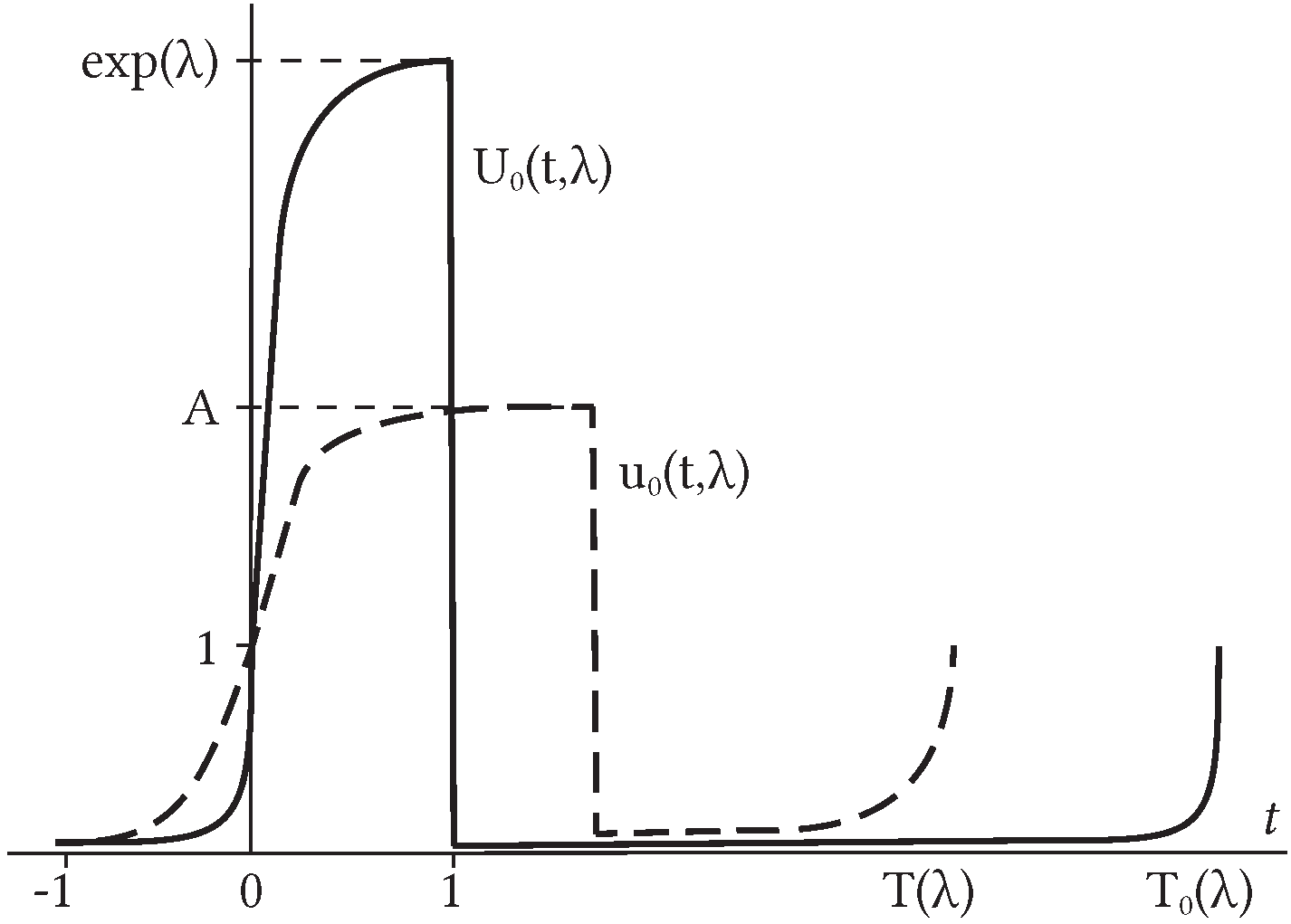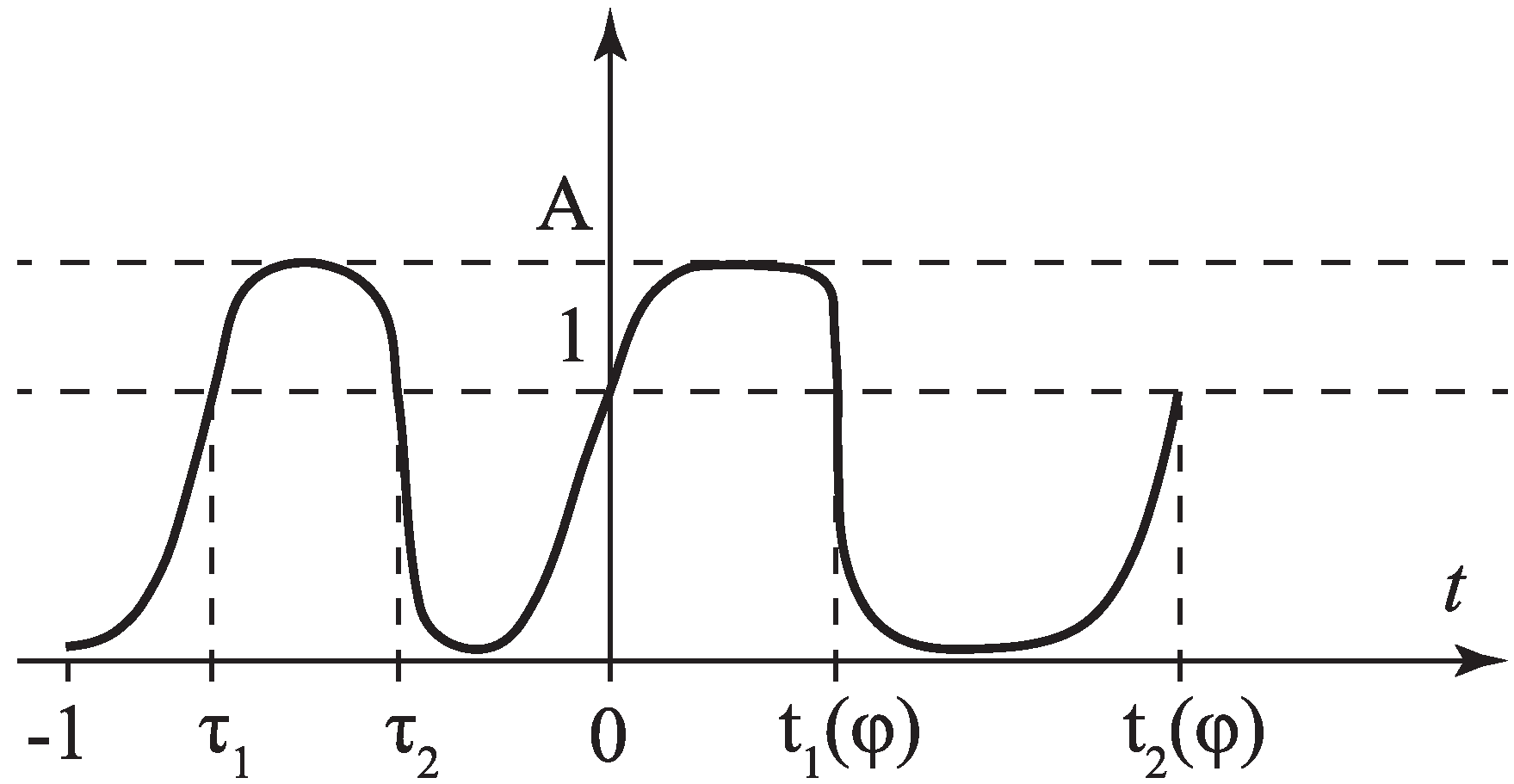Relaxation Oscillations in the Logistic Equation with Delay and Modified Nonlinearity
Abstract
:1. Introduction
2. Andronov–Hopf Bifurcations in Equations with One Delay
3. Step-like Solutions of the Logistic Equation with Delay and with a Restriction on the Nonlinear Function
3.1. Asymptotic Behavior of Slowly Oscillating Solutions
3.2. Rapidly Oscillating Solutions of Equation (24)
4. Step-like Solutions of the Equation with Two Delays
4.1. Construction of Slowly Oscillating Solutions
4.2. Construction of More Complicated Solutions
5. Conclusions
Author Contributions
Funding
Data Availability Statement
Conflicts of Interest
References
- Murray, J.D. Mathematical Biology II, 3rd ed.; Springer: New York, NY, USA, 2003. [Google Scholar] [CrossRef]
- Okuba, A. Dynamical aspects of animal grouping: Swarms, schools, flocks, and herds. Adv. Biophys. 1986, 22, 1–94. [Google Scholar] [CrossRef] [PubMed]
- Wu, J. Theory and Applications of Partial Functional Differential Equations; Springer: New York, NY, USA, 1996. [Google Scholar] [CrossRef]
- Kuang, Y. Delay Differential Equations: With Applications in Population Dynamics; Academic Press: Boston, MA, USA, 1993; Available online: http://www.ams.org/mathscinet-getitem?mr=1218880 (accessed on 1 December 2022).
- Wright, E.M. A non-linear difference-differential equation. J. Reine Angew. Math. 1955, 194, 66–87. [Google Scholar] [CrossRef]
- Kashchenko, S.A.; Loginov, D.O. Estimation of the Region of Global Stability of the Equilibrium State of the Logistic Equation with Delay. Russ. Math. 2020, 64, 34–49. [Google Scholar] [CrossRef]
- Kashchenko, S.A. Asymptotics of the Solutions of the Generalized Hutchinson Equation. Autom. Control Comput. Sci. 2013, 47, 470–494. [Google Scholar] [CrossRef]
- May, R.M. Stability and Complexity in Model Ecosystems, 2nd ed.; Princeton University Press: Princeton, NJ, USA, 2001. [Google Scholar] [CrossRef]
- Dorini, F.A.; Cecconello, M.S.; Dorini, L.B. On the logistic equation subject to uncertainties in the environmental carrying capacity and initial population density. Commun. Nonlinear Sci. Numer. Simul. 2016, 33, 160–173. [Google Scholar] [CrossRef]
- Cushing, J.M. Integrodifferential Equations and Delay Models in Population Dynamics; Springer Science & Business Media: Berlin/Heidelberg, Germany, 2013. [Google Scholar]
- Brauer, F.; Castillo-Chavez, C. Mathematical Models in Population Biology and Epidemiology; Springer: New York, NY, USA, 2012. [Google Scholar] [CrossRef]
- Jin, Z.; Yuan, R. Hopf bifurcation in a reaction-diffusion-advection equation with nonlocal delay effect. J. Differ. Equ. 2021, 271, 533–562. [Google Scholar] [CrossRef]
- Goryunov, V.E. Dynamics of solutions of logistic equation with delay and diffusion in a planar domain. Theor. Math. Phys. 2022, 212, 1092–1110. [Google Scholar] [CrossRef]
- Sawada, Y.; Takeuchi, Y.; Dong, Y. Stability analysis of a single-species logistic model with time delay and constant inflow. Appl. Math. Lett. 2023, 138, 108514. [Google Scholar] [CrossRef]
- Sorokin, V.G.; Vyazmin, A.V. Nonlinear Reaction–Diffusion Equations with Delay: Partial Survey, Exact Solutions, Test Problems, and Numerical Integration. Mathematics 2022, 10, 1886. [Google Scholar] [CrossRef]
- Hale, J.K. Theory of Functional Differential Equations, 2nd ed.; Springer: New York, NY, USA, 1977. [Google Scholar] [CrossRef]
- Oster, G.; Guckenheimer, J. Chapter Bifurcation Phenomena in Population Models. In The Hopf Bifurcation and Its Applications; Springer: New York, NY, USA, 1976; pp. 327–353. [Google Scholar] [CrossRef]
- Marsden, J.E.; McCracken, M.F. The Hopf Bifurcation and Its Applications; Springer: New York, NY, USA, 1976. [Google Scholar] [CrossRef]
- Gourley, S.A.; Sou, J.W.H.; Wu, J.H. Nonlocality of Reaction-Diffusion Equations Induced by Delay: Biological Modeling and Nonlinear Dynamics. J. Math. Sci. 2004, 124, 5119–5153. [Google Scholar] [CrossRef]
- Kashchenko, S.A. Infinite-Dimensional Bifurcations in Spatially Distributed Delay Logistic Equation. Mathematics 2022, 10, 775. [Google Scholar] [CrossRef]
- Jiang, D.; Shi, N. A note on nonautonomous logistic equation with random perturbation. J. Math. Anal. Appl. 2005, 303, 164–172. [Google Scholar] [CrossRef] [Green Version]
- Golubenets, V.O. Relaxation oscillations in a logistic equation with nonconstant delay. Math. Notes 2020, 107, 920–932. [Google Scholar] [CrossRef]
- Edwards, R.E. Functional Analysis. Theory and Applications; Holt, Rinehart and Winston: New York, NY, USA, 1965. [Google Scholar]
- Chen, F.; Shi, J. Periodicity in a logistic type system with several delays. Comput. Math. Appl. 2004, 48, 35–44. [Google Scholar] [CrossRef] [Green Version]
- Smith, H. An Introduction to Delay Differential Equations with Applications to the Life Sciences; Springer: Berlin/Heidelberg, Germany, 2011. [Google Scholar] [CrossRef]
- Kashchenko, I.; Kaschenko, S. Infinite process of forward and backward bifurcations in the logistic equation with two delays. Nonlinear Phenom. Complex Syst. 2019, 22, 407–412. [Google Scholar] [CrossRef]
- Yan, X.P.; Zhang, C.H. Bifurcation analysis in a diffusive Logistic population model with two delayed density-dependent feedback terms. Nonlinear Anal. Real World Appl. 2022, 63, 103394. [Google Scholar] [CrossRef]
- Hartman, P. Ordinary Differential Equations, 2nd ed.; Society for Industrial and Applied Mathematics (SIAM): Philadelphia, PA, USA, 2002. [Google Scholar] [CrossRef]
- Kashchenko, S.A. Relaxation oscillations in a system with delays modeling the predator–prey problem. Autom. Control Comput. Sci. 2015, 49, 547–581. [Google Scholar] [CrossRef] [Green Version]
- Kashchenko, A.A. Relaxation modes of a system of diffusion coupled oscillators with delay. Commun. Nonlinear. Sci. Numer. Simulat. 2021, 93, 105488. [Google Scholar] [CrossRef]
- Kashchenko, A. Asymptotics of Solutions to a Differential Equation with Delay and Nonlinearity Having Simple Behaviour at Infinity. Mathematics 2022, 10, 3360. [Google Scholar] [CrossRef]
- Kashchenko, A.A. Influence of coupling on the dynamics of three delayed oscillators. Izv. VUZ. Appl. Nonlinear Dyn. 2021, 29, 869–891. [Google Scholar] [CrossRef]
- Kashchenko, A.A. Dependence of the dynamics of a model of coupled oscillators on the number of oscillators. Dokl. Math. 2021, 104, 355–359. [Google Scholar] [CrossRef]



Disclaimer/Publisher’s Note: The statements, opinions and data contained in all publications are solely those of the individual author(s) and contributor(s) and not of MDPI and/or the editor(s). MDPI and/or the editor(s) disclaim responsibility for any injury to people or property resulting from any ideas, methods, instructions or products referred to in the content. |
© 2023 by the authors. Licensee MDPI, Basel, Switzerland. This article is an open access article distributed under the terms and conditions of the Creative Commons Attribution (CC BY) license (https://creativecommons.org/licenses/by/4.0/).
Share and Cite
Kashchenko, A.; Kashchenko, S. Relaxation Oscillations in the Logistic Equation with Delay and Modified Nonlinearity. Mathematics 2023, 11, 1699. https://doi.org/10.3390/math11071699
Kashchenko A, Kashchenko S. Relaxation Oscillations in the Logistic Equation with Delay and Modified Nonlinearity. Mathematics. 2023; 11(7):1699. https://doi.org/10.3390/math11071699
Chicago/Turabian StyleKashchenko, Alexandra, and Sergey Kashchenko. 2023. "Relaxation Oscillations in the Logistic Equation with Delay and Modified Nonlinearity" Mathematics 11, no. 7: 1699. https://doi.org/10.3390/math11071699





